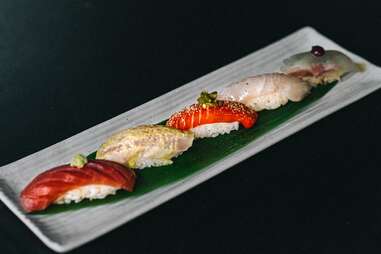For a Model in Sustainable Sushi, Look No Further Than Oregon
From albacore to unagi, here’s how to spot responsibly sourced seafood on menus.

Normally, a casual night out for sushi doesn’t require much thought. The allure is being able to grab whatever salmon nigiri glides your way on the conveyor belt or trusting the omakase menu to guide you toward your next roll loaded with freshly sliced fish.
But in Oregon, every step of the seafood process has been meticulously thought out, from policy to plate, ensuring the most sustainable sushi option ends up on your table.
This can all be traced back to Portland Mayor Vera Katz, who drafted and adopted a first-in-the-nation set of urban sustainability principles nearly 30 years ago. The Sustainable City Principles continue to shape the city’s environmental policies to this day and, yes, make an impact on what’s inside your unagi and crab roll.
Her guidelines met the moment globally—adopted at a time when world governments first mobilized to respond to the threat of climate change—but also served as the guiding blueprint for the city’s efforts to mitigate harm on local wildlife and, in turn, permeated its sprawling food and bar scene.
Seafood, of course, has become increasingly vulnerable to climate change and overfishing, according to the Marine Stewardship Council (MSC). And, as one of the greenest cities in America, Portland is a mecca for the sustainable seafood movement—from being the starting grounds for restaurants like Bamboo Sushi, the world’s first MSC-certified sushi restaurant, to pioneering local programs like the Endangered Species Act Program. What began as local policy has transformed a so-called “parochial backwater” into an all encompassing, globally known food culture that lives and dies by the mantra “local, organic, and sustainable.”
“Portland really blew me away,” says Top Chef star and James Beard Award winning chef Gregory Gourdet, who moved from New York City to head Portland’s Departure Restaurant + Lounge more than a decade ago. “I was amazed with the produce, from the bounty of berries, hazelnuts, mushrooms, and seafood. We are so directly connected to the people who grow our food here. It makes a difference when you know who your farmer is and you’re having honest conversations about what they’re growing or can’t grow because of the heat waves or a snowstorm.”
For Gourdet—who opened his own restaurant, Kann, in summer 2022 in Portland—the decades-long push for more sustainable seafood, from its sourcing to transportation, is responding to the larger, urgent global issue of overfishing.
According to the United Nations’ Food and Agriculture Organization, more than 35 percent of global fisheries are fishing at unsustainable levels, leading to rapidly depleting populations of seafood mainstays like bluefin tuna and salmon across the world.
With the global demand for seafood at historic highs, and with a growing number of fish populations on the brink of extinction, Gourdet says that both chefs and diners have a responsibility to heed the call to save our ocean’s ecosystems. “As chefs, there is an extra level of responsibility we all should have to help inform our guests,” he says. “It’s our responsibility as stewards of the land to offer options that are good for you and the planet.”
Hardly anywhere is this more evident than Portland sushi restaurant Bamboo Sushi, which now has expanded to nearly 10 locations in Seattle, Denver, and California. “It’s a finite resource, but we’re treating it like it’s an infinite resource,” says Bamboo chef Jin Soo Yang. “We’re going to have to wake up to the day that this is not going to be ok.”

What does sustainable seafood actually mean?
While the term “sustainable” has become a nebulous marketing term, slapped on everything from laptops to fast fashion, Yang is clear-eyed about what it means for seafood. “It’s become too marketable. Now, everybody’s ‘sustainable.’” he says. “I want to stop using the word ‘sustainability.’ Let’s talk purpose. Let’s talk about the actions that we’re taking.”
At Bamboo Sushi, he’s crafted a research-heavy process to source ingredients for his chefs’ sushi creations, one that involves independent research, personal outreach to fishers on the scene, and cross-referencing certifications and endangered fish species from the Monterey Bay Aquarium (MBA), Asian Seafood Improvement Collaborative, and MSC.
The process is so intensive that Yang has created a supply chain and sustainability director position within the company, someone who directly communicates with fisheries and fishers to make sure that Bamboo Sushi is serving “the most sustainable product at the best price.”
“Let’s discuss different life cycles of fish, how long does it take for them to rebound, how long does it take for them to get to sexual maturity,” Yang explains. “Let’s look into the fisheries—who’s managing their fishery appropriately? Even if it’s scary or expensive, it’s a mission right? We’re here for a purpose.”
Gourdet says that he also deploys a similarly all-encompassing vetting process that utilizes resources like MSC and MBA, and considers the sustainability of the whole of the process, from the sourcing to the packaging to the carbon emissions generated from the transportation. “Oftentimes, I question shipping fish from all over the world, even if it is the most sustainable,” he says. “Do I really need to fly in salmon from New Zealand and what’s the impact of that on the environment even through it’s ‘sustainable seafood’?”
But, even research has its limits. When it comes to imported seafood from fisheries abroad, particularly Japan, Yang says there’s a frustrating lack of public information available on supply chain traceability and farming standards.
Take, for example, unagi or eel, which has been broadly deemed unsustainable because of opaque farming standards abroad and its rapidly depleting populations both in the US and Japan. Yang says he’s been working for years to find sustainable sources of eel to serve at Bamboo Sushi—efforts that went unanswered until two years ago with the opening of American Unagi, the nation’s first glass eel farm. (The product is used in Bamboo’s Zig Zag Roll.)
“You’d be amazed at how much of a lack of information there is out there, depending on what fisheries in different countries feel comfortable telling us,” Yang says.
For both Gourdet and Yang, sourcing their ingredients locally from fishers and farmers is an integral part of their approaches to sustainability. Part of it is practical—it’s easier to vet fishing or farming practices when you directly know and interact with the fisher. Plus, there are lower carbon emissions involved with local transport and processing.
The menu at Bamboo Sushi heavily features albacore from Oregon—whether diners opt to drape it atop the popular Green Machine Roll or have it gently seared as nigiri. Other popular items include kampachi from Hawaii served with yuzu juice and truffle sauce and coho salmon from Alaska rolled alongside avocado and crispy kaiso. All told, Yang estimates that about 80% of the seafood served at the restaurant is domestic.

Sustainability beyond the menu
The other part of the sustainable seafood ethos is philosophical. Both Yang and Gourdet believe that a true sustainability effort starts locally, and, true to Katz’s principles, is defined by how they support their local community, from their workers to the residents.
“We are a smaller community and we have direct relationships with so many of the people who grow food here,” Gourdet says. “It’s been extremely important to me that I am connected with the people who helped organize all of our great resources. Local is definitely the best choice when we talk about the bigger picture of sustainability.”
Yangs says that sustainability, for him, is also defined by how Bamboo Sushi treats its workers. While the nuts and bolts of sustainability as it relates to seafood matter, Yang says that he approaches the term “holistically” within his company. The restaurant offers one fully-paid eight-hour shift for employees to volunteer in the local community, whether that be at a soup kitchen or a trash pickup.
“Sustainability for us is not a gimmick, it’s an ethos,” Yang explains. “Our sustainability is the way we treat our people. We want to make sure that people understand that our sustainability is not just for the product we serve to our guests.”
It’s a belief system that Gourdet says that he’s creating at Kann, his ode to Haitian cuisine (“The most delicious food in the world.”) and the bounty of Oregon. “Sustainability just means creating systems where everyone can thrive for a long time,” Gourdet says. “That means team mental health and having an equitable workplace. That’s a big part of it, too.”

How to prioritize sustainable seafood as a consumer
Both Gourdet and Yang recommend using the Marine Stewardship Council as a resource for vetting sustainable fish and fisheries, and for good reason.
Founded in 1997 following the collapse of the Grand Banks cod fishery in Canada, the MSC has spearheaded global efforts to curb overfishing through its sustainability standards and fishery certification program.
According to Dan Averill, MSC’s senior fisheries manager, the certification process is multi-pronged and intensive, taking place over a 12-month span and conducted by a third-party assessor. Averill says that a MSC-certified fishery must meet three requirements: it must fish from sustainable populations that can remain productive and healthy into the future, minimize its impacts on marine ecosystems, and maintain effective, adaptable fishery management that meets local, state, and federal fishing regulations.
Fisheries that meet the MSC’s certification standards can earn the nonprofit’s blue fish product label—a sign that a seafood product is ecological, from the fishery to the grocery store.
“The fishery must also undergo annual audits and re-certification every five years,” Averill says. “Fisheries are resilient and dynamic, so a fishery whose populations are struggling one year can be flourishing the next. So, that’s why there are checks and balances in the MSC program to make sure that fisheries are under regular surveillance for changing conditions.”
Beyond looking for the blue seal, if you’re at a restaurant and unsure of whether or not you’re engaging in sustainable consumption, Gourdet recommends using apps like Seafood Watch to see what fish populations are endangered and directly asking restaurants where they source their seafood.
“It’s important to not be afraid to ask your servers where your fish is from and whether it’s sustainable,” says Gourdet. “I think that’s a fair question and we as people who operate in hospitality should have those answers for you. It’s also important that people know what they’re putting in their bodies and where it comes from.”
The impulse to invest and participate in sustainable forms of consumption is natural. After all, Yang says, “our dollar is our vote,” but he implores consumers to directly engage with policymakers in charge of local, state, and federal policies, and to vote based on their convictions. After all, Portland’s sustainability culture didn’t just come out of nowhere: it was born from city policy crafted by Katz back in 1994, and built on by successive administrations.
“People always joke, ‘Write your local representative,’ but it works! They work for us,” Yang says. “If you want change, you have to be involved. You can’t let other people change it for you.”
